Abstract
Rhodococcus equi, a facultative intracellular gram-positive bacterium, can induce life-threatening infections in immunocompromised patients, especially those with AIDS. We have studied the mechanism of acquired immunity to this pathogen in a murine model. Protective immunity was induced by live but not killed bacteria. Adoptive transfer of resistance was obtained with spleen cells but not immune serum from mice immunized intravenously 30 days earlier with live bacteria. In normal mice, an intravenous challenge of 5 x 10(6) CFU of R. equi was cleared from the spleen, liver, and lungs within 3 weeks, whereas athymic nude mice were unable to clear the bacteria. In vivo depletion with monoclonal antibodies showed that both CD4+ and CD8+ T-cell subsets participate in the clearance of bacteria and that CD8+ T cells play the major role.
Full text
PDF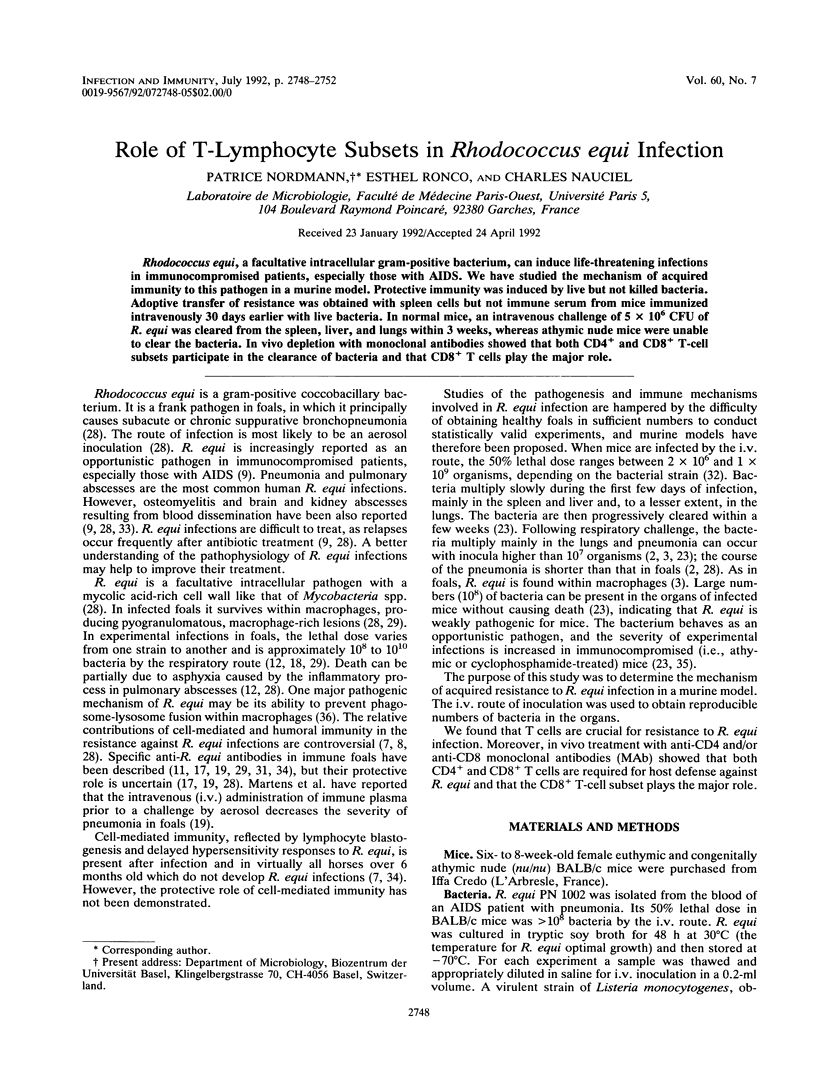
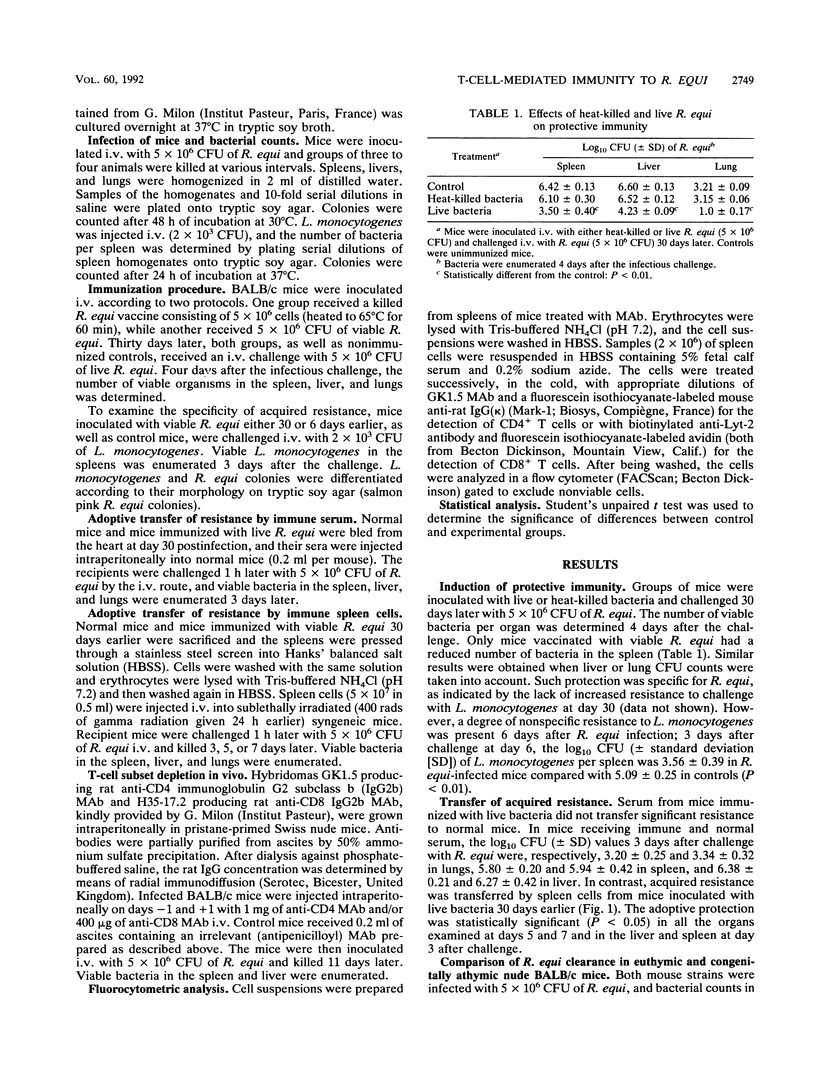
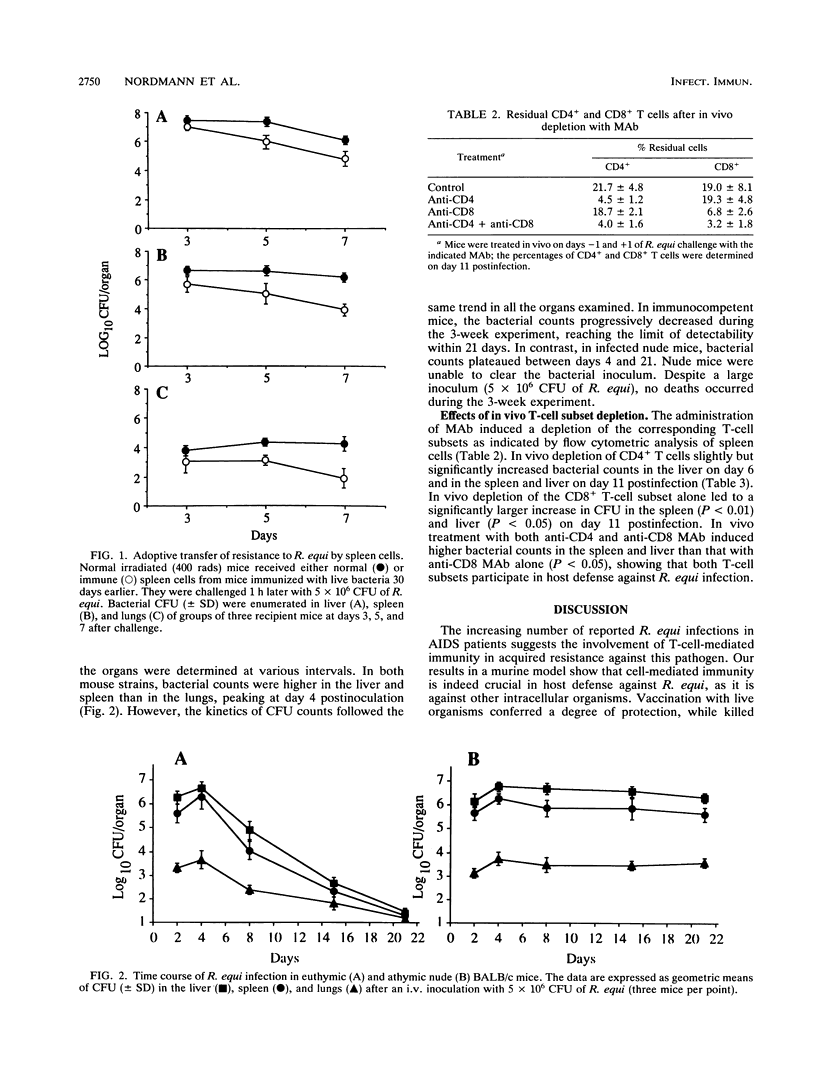
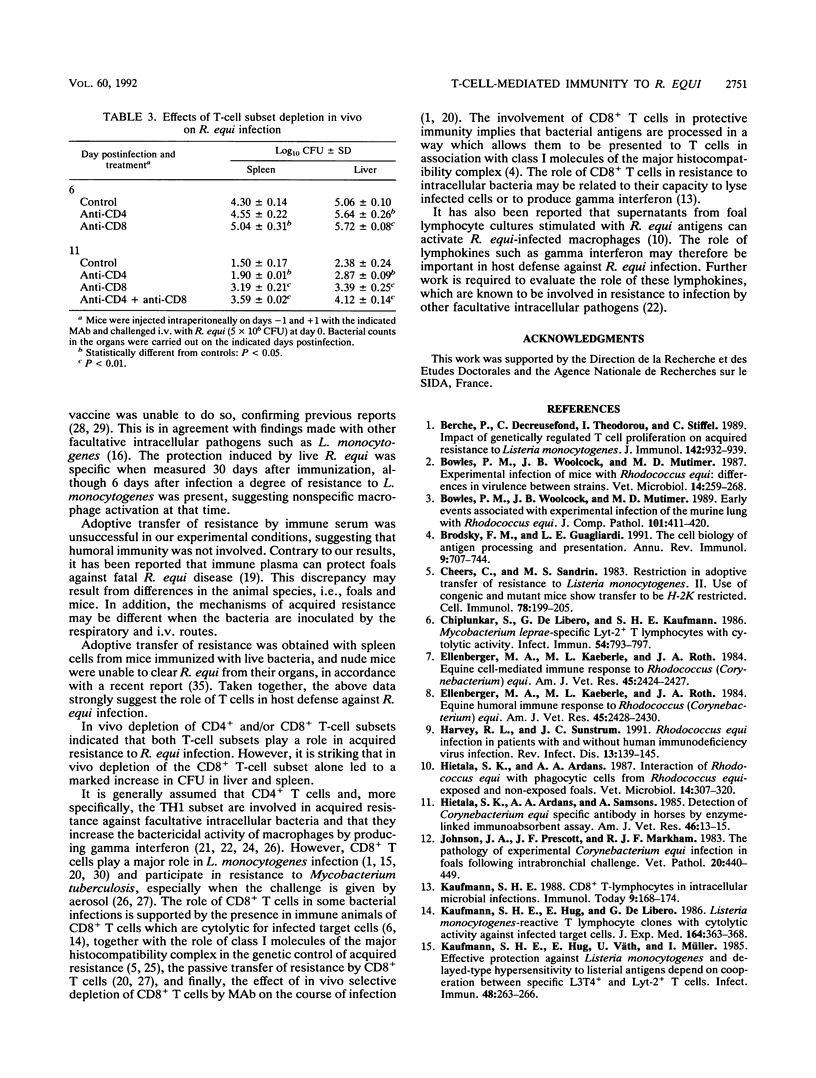
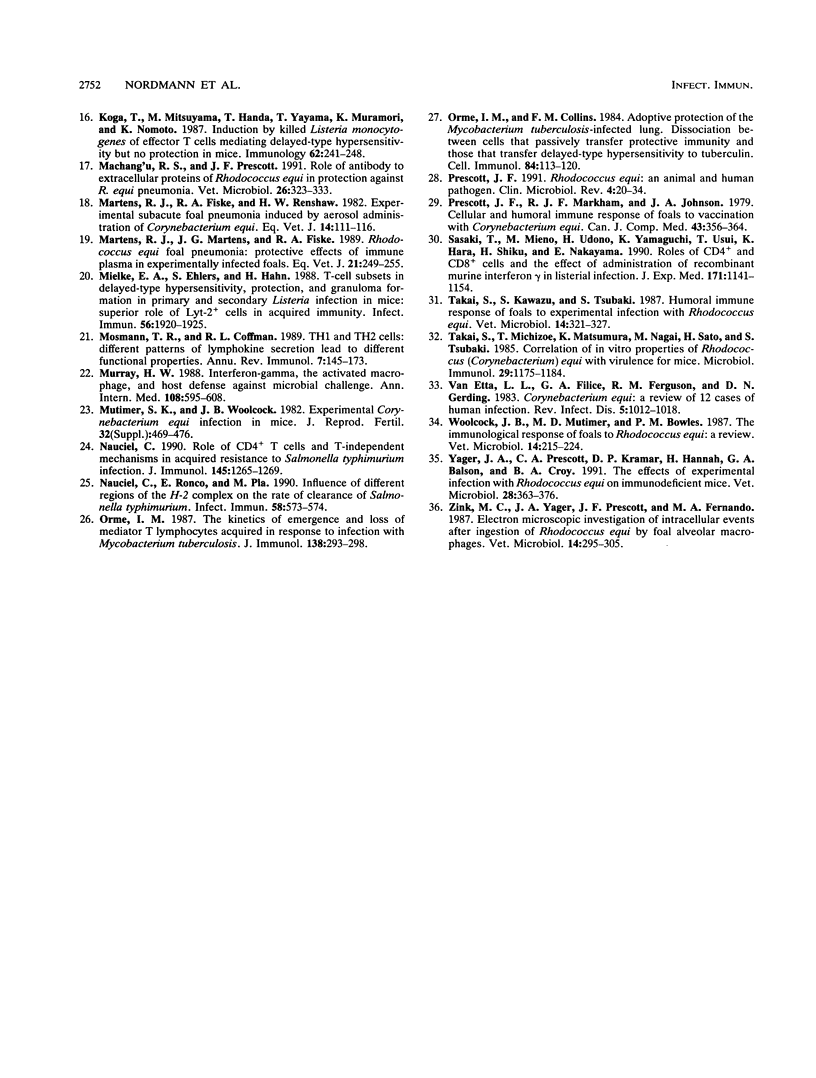
Selected References
These references are in PubMed. This may not be the complete list of references from this article.
- Berche P., Decreusefond C., Theodorou I., Stiffel C. Impact of genetically regulated T cell proliferation on acquired resistance to Listeria monocytogenes. J Immunol. 1989 Feb 1;142(3):932–939. [PubMed] [Google Scholar]
- Bowles P. M., Woolcock J. B., Mutimer M. D. Early events associated with experimental infection of the murine lung with Rhodococcus equi. J Comp Pathol. 1989 Nov;101(4):411–420. doi: 10.1016/0021-9975(89)90024-8. [DOI] [PubMed] [Google Scholar]
- Bowles P. M., Woolcock J. B., Mutimer M. D. Experimental infection of mice with Rhodococcus equi: differences in virulence between strains. Vet Microbiol. 1987 Aug;14(3):259–268. doi: 10.1016/0378-1135(87)90113-1. [DOI] [PubMed] [Google Scholar]
- Brodsky F. M., Guagliardi L. E. The cell biology of antigen processing and presentation. Annu Rev Immunol. 1991;9:707–744. doi: 10.1146/annurev.iy.09.040191.003423. [DOI] [PubMed] [Google Scholar]
- Cheers C., Sandrin M. S. Restriction in adoptive transfer of resistance to Listeria monocytogenes. II. Use of congenic and mutant mice show transfer to be H-2K restricted. Cell Immunol. 1983 Jun;78(2):199–205. doi: 10.1016/0008-8749(83)90274-5. [DOI] [PubMed] [Google Scholar]
- Chiplunkar S., De Libero G., Kaufmann S. H. Mycobacterium leprae-specific Lyt-2+ T lymphocytes with cytolytic activity. Infect Immun. 1986 Dec;54(3):793–797. doi: 10.1128/iai.54.3.793-797.1986. [DOI] [PMC free article] [PubMed] [Google Scholar]
- Ellenberger M. A., Kaeberle M. L., Roth J. A. Equine cell-mediated immune response to Rhodococcus (Corynebacterium) equi. Am J Vet Res. 1984 Nov;45(11):2424–2427. [PubMed] [Google Scholar]
- Ellenberger M. A., Kaeberle M. L., Roth J. A. Equine humoral immune response to Rhodococcus (Corynebacterium) equi. Am J Vet Res. 1984 Nov;45(11):2428–2430. [PubMed] [Google Scholar]
- Harvey R. L., Sunstrum J. C. Rhodococcus equi infection in patients with and without human immunodeficiency virus infection. Rev Infect Dis. 1991 Jan-Feb;13(1):139–145. doi: 10.1093/clinids/13.1.139. [DOI] [PubMed] [Google Scholar]
- Hietala S. K., Ardans A. A. Interaction of Rhodococcus equi with phagocytic cells from R. equi-exposed and non-exposed foals. Vet Microbiol. 1987 Aug;14(3):307–320. doi: 10.1016/0378-1135(87)90118-0. [DOI] [PubMed] [Google Scholar]
- Hietala S. K., Ardans A. A., Sansome A. Detection of Corynebacterium equi-specific antibody in horses by enzyme-linked immunosorbent assay. Am J Vet Res. 1985 Jan;46(1):13–15. [PubMed] [Google Scholar]
- Johnson J. A., Prescott J. F., Markham R. J. The pathology of experimental Corynebacterium equi infection in foals following intrabronchial challenge. Vet Pathol. 1983 Jul;20(4):440–449. doi: 10.1177/030098588302000407. [DOI] [PubMed] [Google Scholar]
- Kaufmann S. H. CD8+ T lymphocytes in intracellular microbial infections. Immunol Today. 1988 Jun;9(6):168–174. doi: 10.1016/0167-5699(88)91292-3. [DOI] [PubMed] [Google Scholar]
- Kaufmann S. H., Hug E., De Libero G. Listeria monocytogenes-reactive T lymphocyte clones with cytolytic activity against infected target cells. J Exp Med. 1986 Jul 1;164(1):363–368. doi: 10.1084/jem.164.1.363. [DOI] [PMC free article] [PubMed] [Google Scholar]
- Kaufmann S. H., Hug E., Väth U., Müller I. Effective protection against Listeria monocytogenes and delayed-type hypersensitivity to listerial antigens depend on cooperation between specific L3T4+ and Lyt 2+ T cells. Infect Immun. 1985 Apr;48(1):263–266. doi: 10.1128/iai.48.1.263-266.1985. [DOI] [PMC free article] [PubMed] [Google Scholar]
- Koga T., Mitsuyama M., Handa T., Yayama T., Muramori K., Nomoto K. Induction by killed Listeria monocytogenes of effector T cells mediating delayed-type hypersensitivity but not protection in mice. Immunology. 1987 Oct;62(2):241–248. [PMC free article] [PubMed] [Google Scholar]
- Machang'u R. S., Prescott J. F. Role of antibody to extracellular proteins of Rhodococcus equi in protection against R. equi pneumonia in foals. Vet Microbiol. 1991 Feb 15;26(4):323–333. doi: 10.1016/0378-1135(91)90026-c. [DOI] [PubMed] [Google Scholar]
- Martens R. J., Fiske R. A., Renshaw H. W. Experimental subacute foal pneumonia induced by aerosol administration of Corynebacterium equi. Equine Vet J. 1982 Apr;14(2):111–116. doi: 10.1111/j.2042-3306.1982.tb02359.x. [DOI] [PubMed] [Google Scholar]
- Martens R. J., Martens J. G., Fiske R. A., Hietala S. K. Rhodococcus equi foal pneumonia: protective effects of immune plasma in experimentally infected foals. Equine Vet J. 1989 Jul;21(4):249–255. doi: 10.1111/j.2042-3306.1989.tb02161.x. [DOI] [PubMed] [Google Scholar]
- Mielke M. E., Ehlers S., Hahn H. T-cell subsets in delayed-type hypersensitivity, protection, and granuloma formation in primary and secondary Listeria infection in mice: superior role of Lyt-2+ cells in acquired immunity. Infect Immun. 1988 Aug;56(8):1920–1925. doi: 10.1128/iai.56.8.1920-1925.1988. [DOI] [PMC free article] [PubMed] [Google Scholar]
- Mosmann T. R., Coffman R. L. TH1 and TH2 cells: different patterns of lymphokine secretion lead to different functional properties. Annu Rev Immunol. 1989;7:145–173. doi: 10.1146/annurev.iy.07.040189.001045. [DOI] [PubMed] [Google Scholar]
- Murray H. W. Interferon-gamma, the activated macrophage, and host defense against microbial challenge. Ann Intern Med. 1988 Apr;108(4):595–608. doi: 10.7326/0003-4819-108-4-595. [DOI] [PubMed] [Google Scholar]
- Mutimer M. D., Woolcock J. B. Experimental Corynebacterium equi infection in mice. J Reprod Fertil Suppl. 1982;32:469–476. [PubMed] [Google Scholar]
- Nauciel C. Role of CD4+ T cells and T-independent mechanisms in acquired resistance to Salmonella typhimurium infection. J Immunol. 1990 Aug 15;145(4):1265–1269. [PubMed] [Google Scholar]
- Nauciel C., Ronco E., Pla M. Influence of different regions of the H-2 complex on the rate of clearance of Salmonella typhimurium. Infect Immun. 1990 Feb;58(2):573–574. doi: 10.1128/iai.58.2.573-574.1990. [DOI] [PMC free article] [PubMed] [Google Scholar]
- Orme I. M., Collins F. M. Adoptive protection of the Mycobacterium tuberculosis-infected lung. Dissociation between cells that passively transfer protective immunity and those that transfer delayed-type hypersensitivity to tuberculin. Cell Immunol. 1984 Mar;84(1):113–120. doi: 10.1016/0008-8749(84)90082-0. [DOI] [PubMed] [Google Scholar]
- Orme I. M. The kinetics of emergence and loss of mediator T lymphocytes acquired in response to infection with Mycobacterium tuberculosis. J Immunol. 1987 Jan 1;138(1):293–298. [PubMed] [Google Scholar]
- Prescott J. F., Markham R. J., Johnson J. A. Cellular and humoral immune response of foals to vaccination with Corynebacterium equi. Can J Comp Med. 1979 Oct;43(4):356–364. [PMC free article] [PubMed] [Google Scholar]
- Prescott J. F. Rhodococcus equi: an animal and human pathogen. Clin Microbiol Rev. 1991 Jan;4(1):20–34. doi: 10.1128/cmr.4.1.20. [DOI] [PMC free article] [PubMed] [Google Scholar]
- Sasaki T., Mieno M., Udono H., Yamaguchi K., Usui T., Hara K., Shiku H., Nakayama E. Roles of CD4+ and CD8+ cells, and the effect of administration of recombinant murine interferon gamma in listerial infection. J Exp Med. 1990 Apr 1;171(4):1141–1154. doi: 10.1084/jem.171.4.1141. [DOI] [PMC free article] [PubMed] [Google Scholar]
- Takai S., Kawazu S., Tsubaki S. Humoral immune response of foals to experimental infection with Rhodococcus equi. Vet Microbiol. 1987 Aug;14(3):321–327. doi: 10.1016/0378-1135(87)90119-2. [DOI] [PubMed] [Google Scholar]
- Takai S., Michizoe T., Matsumura K., Nagai M., Sato H., Tsubaki S. Correlation of in vitro properties of Rhodococcus (Corynebacterium) equi with virulence for mice. Microbiol Immunol. 1985;29(12):1175–1184. doi: 10.1111/j.1348-0421.1985.tb00907.x. [DOI] [PubMed] [Google Scholar]
- Van Etta L. L., Filice G. A., Ferguson R. M., Gerding D. N. Corynebacterium equi: a review of 12 cases of human infection. Rev Infect Dis. 1983 Nov-Dec;5(6):1012–1018. doi: 10.1093/clinids/5.6.1012. [DOI] [PubMed] [Google Scholar]
- Woolcock J. B., Mutimer M. D., Bowles P. M. The immunological response of foals to Rhodococcus equi: a review. Vet Microbiol. 1987 Aug;14(3):215–224. doi: 10.1016/0378-1135(87)90108-8. [DOI] [PubMed] [Google Scholar]
- Yager J. A., Prescott C. A., Kramar D. P., Hannah H., Balson G. A., Croy B. A. The effect of experimental infection with Rhodococcus equi on immunodeficient mice. Vet Microbiol. 1991 Aug 30;28(4):363–376. doi: 10.1016/0378-1135(91)90071-m. [DOI] [PubMed] [Google Scholar]
- Zink M. C., Yager J. A., Prescott J. F., Fernando M. A. Electron microscopic investigation of intracellular events after ingestion of Rhodococcus equi by foal alveolar macrophages. Vet Microbiol. 1987 Aug;14(3):295–305. doi: 10.1016/0378-1135(87)90117-9. [DOI] [PubMed] [Google Scholar]


